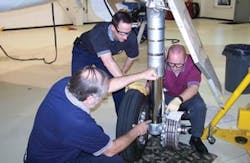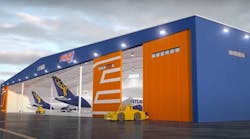Ever since I departed the role as tech rep for an airframe manufacturer, I have noticed subtle changes in my life. First, I no longer need blood pressure medicine. Secondly, my cell phone usage has gone from 3,000 minutes a month to less than 100.
This new relaxed life style gives me some time for contemplation which, on a few occasions, promotes revelations. A while back while talking with an old friend and listening to him describe a recent event with our health care system, it came to me. He was relating a tale of a painful hangnail and when I asked if he had gone to a doctor, his response was yes. It seems his wife’s brother is a proctologist with an office not far from the airport. Within two days of treatment a serious infection set in requiring further treatment from a wound specialist and 10 days of antibiotics. I, of course, related this experience to aviation maintenance. Would it be prudent to contact someone with extensive engine overhaul experience to troubleshoot an auto pilot problem?
A&P: all purpose
It is assumed by many that the (A&P) abbreviation for Airframe and Powerplant technician is in fact an acronym for All Purpose and in fact in some operations that is the expectation.
Is it an unreasonable assessment? Not necessarily. In business aviation, organizations that have one or two aircraft and one or two technicians might be very well equipped to handle most day-to-day nose-to-tail maintenance. When it comes to the heavy checks a specialized service center might fill the void.
Early in my career while working for a maintenance repair organization (MRO) we had separate airframe and powerplant shops where the mechanics from the airframe department would work side by side with people from the engine shop. At that time, it was commonplace to segregate the avionics types as they were, for the most part, a strange lot who did not care for getting their hands dirty.
Initiation to avionics
My official initiation to the avionics world came as a result of working on Lear Jets that required a technician to go along on stall test flights to facilitate adjustments to the stall system computer. It just so happened that none of the currently employed technicians had the stomach for the required maneuvers. Usually two dozen deep stalls were needed and early Lears were not known for their docile stall characteristics. At the conclusion of the flight, the factory test pilot told the avionics shop manager that I was able to make all the adjustments and did not get air sick. I was appointed “Avionics Technician” on the spot. That night while at home contemplating the day’s events, I began to wonder when the avionics elves would arrive to impart their knowledge and wisdom about such things as autopilots and navigation and communication systems. After all, where would I acquire all the “need to know” of the trade?
FAR guidance
Perhaps we can find some guidance in the Federal Aviation Regulations (FAR). Part 65 does provide some insight:
§ 65.81 General privileges and limitations.
(a) A certificated mechanic may perform or supervise the maintenance, preventive maintenance, or alteration of an aircraft or appliance, or a part thereof, for which he is rated (but excluding major repairs to, and major alterations of, propellers, and any repair to, or alteration of, instruments), and may perform additional duties in accordance with §§65.85, 65.87, and 65.95. However, he may not supervise the maintenance, preventive maintenance, or alteration of, or approve and return to service, any aircraft or appliance, or part thereof, for which he is rated unless he has satisfactorily performed the work concerned at an earlier date. If he has not so performed that work at an earlier date, he may show his ability to do it by performing it to the satisfaction of the Administrator or under the direct supervision of a certificated and appropriately rated mechanic, or a certificated repairman, who has had previous experience in the specific operation concerned.
(b) A certificated mechanic may not exercise the privileges of his certificate and rating unless he understands the current instructions of the manufacturer, and the maintenance manuals, for the specific operation concerned.
Tribal knowledge
So where does the understanding originate? Per Part 65, a big part of it is tribal knowledge. That is the passing down of special useful information from the experienced to the inexperienced. This practice has served the industry well for the first 100 years but with the current employment trends and advancing technology, “need to know” has changed.
Many of us have been well versed on inspection techniques for wiring in aging aircraft. We know how to look for corrosion in connections and how to identify a deteriorating insulation. Using a multimeter to verify circuit parameters is almost a no brainer for today’s technician.
What about inspecting a digital bus or routing a video cable alongside an antenna coax?
Advisory Circular (AC) 25-26 does provide some basic guidance but does not deliver the tribal knowledge of the resulting circumstance if proper techniques are not used. Impedance critical data buses have been known to produce system failures when exposed to excessive compression as can occur from overtightening clamps or even as a result of the tightening of a bulkhead wiring bung during normal aircraft pressurization.
Many among us today still have a limited knowledge about troubleshooting computer circuits employing discrete or Avionics Standard Communications Bus (ASCB) signals.
In addition, the inspection and maintenance techniques for this new-age equipment involves an education process significantly different than traditional training concepts.
Knowing the procedure to interrogate a digital system for stored faults does provide a definite advantage in the troubleshooting process, but an understanding of the system’s different levels of software and modes of operation can often be the difference in coming up with a true solution versus a possible remedy.
As technology advanced it became increasingly difficult to draw a line where avionics stops and airframe or even engines begin. The rapid advancements in digital technology and the utilization of fiber-optics has made our industry truly challenging. Gaining the knowledge to keep up with technology can be a challenge in and of itself. The avionics elves are not that easy to contact and in many cases they align themselves with the numerous mischief-spreading gremlins that often reside within our aircraft. Several commercial training providers have recognized the dilemma as have a few Part 147 A&P schools. They have in turn created educational programs in an attempt to get those interested up to speed with today’s equipment and procedures.
The important thing, as I see it, is the need to know is something unique to each individual and should be based on situations. A&P in many operations does still mean All Purpose, signifying a broader and perhaps less specialized need to know. The special knowledge here would be more in tune with operational issues and malfunction diagnosis. A technician employed by a maintenance repair organization may need a greater awareness of installation methods.
The need to know is an important part of who we are and is worth being included in the learning process, either in a formal training setting or through contacts in recognized industry forums.
Inquiring minds want to know and the only way to satisfy the need to know is to first ask the question and then take the initiative.
Jim Sparks has been in aviation for 30 years and is a licensed A&P. His career began in general aviation as a mechanic, electrician, and avionics technician. In addition to extensive hands on, Jim created and delivered educational programs for several training organizations and served as a technical representative for a manufacturer of business jets. Currently when not writing for AMT, he is the manager of aviation maintenance for a private company with a fleet including light single engine aircraft, helicopters, and several types of business jets.



